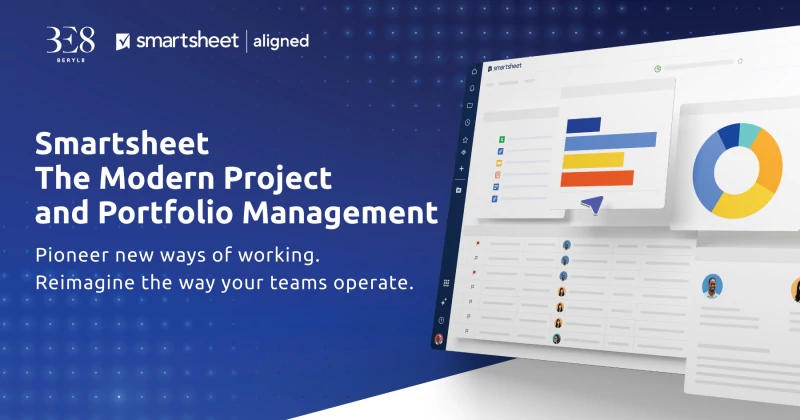The Modern Project and Portfolio Management

How to implement a modern PPM strategy to drive success and deliver value faster
As businesses grow, the amount of work to prioritize, track, and manage increases exponentially.
We’ve created this handbook to help you adopt a modern approach to project and portfolio management (PPM) and ensure that your teams are well-equipped to tackle projects and programs at scale.
What do we mean by taking a modern approach to PPM? This refers
to project and portfolio management that brings together the three most critical elements: people, process, and technology. This approach embraces flexibility, combining collaborative work execution with well- managed standards to oversee growth at scale. It means connecting strategy to execution by standardizing processes without sacrificing user experience. It’s getting ahead of the competition by utilizing the most up-to-date and future-proof tools.
Signs you need to evaluate your approach to PPM
Many of the challenges you may be currently facing can be alleviated with a more modern, thoughtful approach to PPM. These pain points include:
Difficulty in adapting to change: Your current tools are one-size-fits-all, rigid, inflexible, or unable to scale.
Lack of visibility: Your teams and stakeholders have difficulty finding information about projects in progress.
Inefficient collaboration: You struggle to work effectively with team members and other departments.
Limited resource management: You spend more time balancing strict budgets and timelines than getting work done.
Inconsistent project delivery: You are often unable to produce project deliverables on time or on budget.
Lack of strategic alignment: You question how your projects fit into the bigger picture, or what the priorities are.
Inability to harness data insights: You are unable to make informed decisions based on how current projects are performing, or how past projects continue to perform.
Poor stakeholder engagement: You have difficulty describing the advantages of your projects and winning over high-level stakeholders.
Decreased morale: You feel overwhelmed at the sheer volume of work related to managing a project portfolio.
Modern PPM also makes it easier to:
Adapt to changing requirements
Foresee risks before they become major roadblocks
Effectively manage costs, timelines, and labor
Align projects to overall business strategies
Demonstrate value to stakeholders
Increase your project success rate
Empower your teams to deliver their best work
Six steps to set up a modern PPM solution for your business
Businesses of all types and sizes can benefit from implementing modern PPM practices. To set up an effective modern PPM solution that makes sense for your organization, follow these six steps:
Step 1: Set up a PPM tech stack that connects people, processes, and technology.
Your PPM tech stack is the full set of technology tools, platforms, and applications that your team uses to conduct business and track results within your portfolio. There are many different software and tools to consider when building a PPM tech stack to meet the specific needs of your organization. Your stack should include powerful project and portfolio management software in addition to other tools that sync up easily with each other, tie into your business strategy, and can scale along with your organization as it evolves.
As you are evaluating your tech stack, ensure that your PPM platform is easy to learn and use, has the features you require, and integrates well with the other tools you need. These factors make communicating and collaborating with your team easier and help get new processes up and running faster. Additionally, consider software that is highly reviewed and that has a robust support team to aid in setup and troubleshooting.
Step 2: Evaluate channels of communication.
Communication is at the core of successful project and portfolio management. Without effective communication, team members may be unclear on the overall strategic direction of the business, misunderstand large-scale priorities, or perform duplicate or redundant work.
Once you have evaluated and assembled your tech stack, assess the various ways your team shares project information between themselves and with stakeholders. Identify places where communication can be streamlined, and create new processes using your modern PPM tools.
Encourage your teams to communicate visibly about project details to reduce the number of questions that others might have about the status of their work. As the number of people involved in a project grows, so does the possibility of lost or duplicate work. Use your PPM tools to keep communication relevant and centrally located for easy access to all.
Step 3: Review workflows for opportunities to automate.
Modern PPM tools make it easy to automate time-consuming and repetitive tasks like sending status reports, task notifications and assignments, and update requests. Audit your existing processes to find bottlenecks, and then leverage software to ease the burdens of your team.
You can also automate more complex tasks, like intake requests, resource tracking, and updating project plans and dashboards. Automation can free your team from busy work and give them the time back to perform more meaningful work.
Step 4: Ensure portfolio status, goals, and results are visible and transparent.
Visibility into project and portfolio tasks and status helps to foster more inclusive teams and build trust between stakeholders. When everyone can see the work that needs to be done, and the steps required to complete it, they can better anticipate risks and roadblocks that might otherwise become major issues. It is also important to state your goals clearly and share them with stakeholders so that everyone can work toward their achievement.
To facilitate better visibility and transparency, create a single source of truth for project information, including task assignments and status, project schedules, resource allocation, and other important documentation. Modern PPM software allows anyone with access to make updates to project plans or check their status in real-time, from anywhere.
Step 5: Implement data-driven decision-making.
Once you have implemented modern PPM tools and processes, use them to inform your business decisions. PPM software can help track project trends, like success rates, schedule adherence, and budget needs, so use that data to make decisions around prioritization and resource allocation for your portfolio.
Data-driven decision-making leads businesses to more successful outcomes because decisions made on real data are grounded in the real world. Your PPM processes become more sophisticated when you use data about the past to predict what will happen in the future. And as your business grows, so do the costs involved, so relying on instinct alone becomes a much more risky proposition. Modern PPM can help ensure that you’re making the best choices based on your own business realities.
Step 6: Continually assess PPM maturity.
Project and portfolio management success is a moving target, and the benchmarks can change often based on the market and your own priorities. Set a schedule to audit your PPM processes and review your portfolio prioritization based on the changing needs and goals of your organization.
Remain vigilant and flexible on your journey to establish a modern PPM solution for your organization. Regular evaluation and measurement can help your business stay competitive and identify new opportunities for growth as well as anticipate market trends.
Our Maturity Assessment Tool can determine your business’ current PPM maturity and identify growth opportunities to ensure you’re making the most of your project portfolios.
Conclusion
Successful, streamlined PPM can help your business achieve its goals by reducing project costs, optimizing project execution efficiency, and increasing visibility into progress and outcomes. This approach to PPM will better connect your strategy to your execution, making it easier to scale your processes, projects, and programs.
Every organization can benefit from evaluating and optimizing its PPM practices, no matter the current stage of its maturity. With Smartsheet, you’ll find it easy to leverage modern project and portfolio management and empower your teams to drive meaningful change.
Try Smartsheet for FREE! Click or contact for additional details on Smartsheet, please reach out to our team. Click



